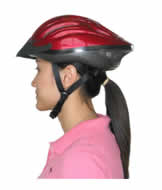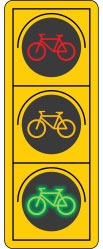
Cycling is a fun and healthy activity. It's a low-cost way to get around, and it's good for the environment.
Before you head out on a bike, learn the rules of the road, helmet information and safety tips for cyclists of all ages.
Cycling guides
Learn more about safe cycling:
- Cycling Skills: Ontario's Guide to Safe Cycling (PDF - 9 MB) : a detailed handbook of rules and safety standards for any rider
- Young Cyclist's Guide (PDF - 2.83 MB) : a kid-friendly handbook of cycling safety tips and rules for young riders
What is a bicycle?
A bicycle, or bike, includes a vehicle that:
- has one, two or three wheels (a unicycle, bicycle or tricycle)
- has steering handlebars and pedals
- does not have a motor. For motor-assisted bikes, read about electric bicycles or scooters and mopeds
Licence and registration
Bicycles do not require:
- registration
- licence plates
- vehicle insurance
- driver's licence
People of all ages can ride a bike.
Rules of the road
As a cyclist, you must share the road with others (e.g., cars, buses, trucks, motorcycles, etc.).
Under Ontario's Highway Traffic Act (HTA), a bicycle is a vehicle, just like a car or truck.
Cyclists:
- must obey all traffic laws
- have the same rights and responsibilities as drivers
- cannot carry passengers - if your bicycle is only meant for one person
Riding on the right
You must stay as close to the right edge of the road as safely as possible when being passed.
Where you can ride
You can ride on most roads, except:
- controlled access highways, such as Ontario's 400-series highways
- across a road within a pedestrian crossover - you must walk your bike to the other side
- across a road within a crosswalk at any intersection or other location with traffic signals - you must walk your bike to the other side.
Bike helmets
Children and youth

By law, every cyclist under age 18 must wear an approved helmet.
Riders under 16 years old: a parent or guardian must make sure their child wears a helmet.
Adults
Helmets are not compulsory for adults over 18. However, a helmet can greatly reduce the risk of permanent injury or death if you fall or collide. It is strongly recommended that all riders wear helmets.
Types of helmets
The best helmets:
- are made to meet strict safety standards
- fit properly when worn correctly
Bicycle safety resources
For more information about cycling safety, check out:
- CAN-BIKE, a series of education and skill courses on cycling safely
- Cycling in Toronto: a citizen's advisory group on bike-related policies
- the Share the Road Cycling Coalition: an organization that works to make communities more bicycle-friendly
- CAA Bike Safety: safety tips for cyclists and drivers
Frequently Asked Questions
Bicycle traffic signals
Q1: What do cyclists need to know about bicycle traffic signals?
As of January 1, 2017:

- New bicycle traffic signals can be used to direct bicycle traffic at intersections
- Cyclists must obey bicycle traffic signals where they are installed
- Cyclists who do not obey bicycle traffic signals can face a set fine of $85 and $120 in community safety zones
- Where both a regular traffic signal and a bicycle traffic signal apply to the same lane, cyclists must obey the bicycle signal
- If no bicycle traffic signals are present, cyclists must obey standard traffic signals
Q2: Why did the province pass legislation for bicycle signals?
Bicycle traffic signals are expected to improve safety at intersections and help reduce collisions with pedestrians and drivers.
One-Metre Passing Law
Q1: What is the penalty to drivers for not leaving a minimum of one-metre distance when passing a cyclist?
The penalty for not leaving a minimum one-metre passing distance is a set fine of $85.00 plus a $5 court fee plus a $20 victim surcharge fine for a total payable of $110.00.
Drivers who contest their ticket by going to court may face a fine of up to $500 if found guilty (fine range is $60 to $500). Upon conviction, two demerit points will also be assigned against the individual’s driver record.
Q2: Are cyclists also required to leave a minimum one-metre distance when passing a vehicle?
Cyclists are not required to leave a specific one-metre space. However, they are required to obey all the rules of the road. Cyclists who are being overtaken should turn out to the right to allow the vehicle to pass.
Q3: What if there isn’t enough room to allow for a one-metre passing distance? Can a vehicle cross the centre median line to pass the cyclist?
A motorist may, if done safely, and in compliance with the rules of the road, cross the centre line of a roadway in order to pass a cyclist. If this cannot be done, he or she must wait behind the cyclist until it is safe to pass.
Dooring
Q1. What are the penalties for “dooring” offences?
The penalties for improper opening of a vehicle door (for driver or passenger) are a set fine of $300.00 upon conviction and three demerit points. The total payable fine is $365.00 ($300 set fine plus $60 victim fine surcharge and $5 court costs). Drivers who choose to contest the charge could be subject to a fine up to $1,000 and three demerit points, upon conviction.
Q2. Does the “dooring” law only apply to cyclists?
Although cyclists may be the most commonly perceived road user affected by this behaviour, the “dooring” law applies to all road users and is not specific to cyclists.
The government is committed to helping ensure the safety of not only cyclists but all road users.
Fine for cyclists for non-compliance with light, reflector and reflective material requirements
Q1. What is the penalty for cyclists with improper lights, reflectors and reflective materials on their bicycles (including e-bikes) and motor-assisted bicycles (mopeds)?
Non-compliance with bicycle light, reflector and reflective requirements carries a total payable fine of $110 ($85 set fine plus $20 victim fine surcharge and $5 court fees), which is in line with all other cycling violations.
Allowing cyclists to use intermittent flashing red lights
Q1. Why are cyclists allowed to use a red flashing light? Isn't this distracting to other road users?
A number of cyclists use rear lamps that produce intermittent flashes of red light, which make them more visible to others. Considering the safety benefits from the use of these lights, and to prevent cyclists from potentially being charged under the Highway Traffic Act (HTA), amendments were made to the HTA on September 1, 2015, allowing cyclists to use lamps that produce intermittent flashes of red lights.
A motorist may, if done safely, and in compliance with the rules of the road, cross the centre line of a roadway in order to pass a cyclist. If this cannot be done, he or she must wait behind the cyclist until it is safe to pass.
Bicycle Helmets
Q1: Who is required to wear a bicycle helmet?
All bicycle riders under the age of 18 are required to wear an approved bicycle helmet when travelling on any public road. The total fine for not wearing a helmet is $75.
Q2: How do I know which bicycle helmet to buy?
Look for a helmet that fits comfortably and meets safety standards. Check the inside of the helmet for stickers from one or more of the following organizations:
- Snell Memorial Foundation: Snell B90, Snell B95, Snell B90S, or Snell N94
- American National Standard Institute: ANSI Z90.4-1984
- American Society For Testing and Materials: ASTMF1447-94
- British Standards Institute: BS6863:1989
- Standards Association of Australia: AS2063.2-1990
- United States Consumer Product Safety Commission (CPSC) 16 CFR Part 1203